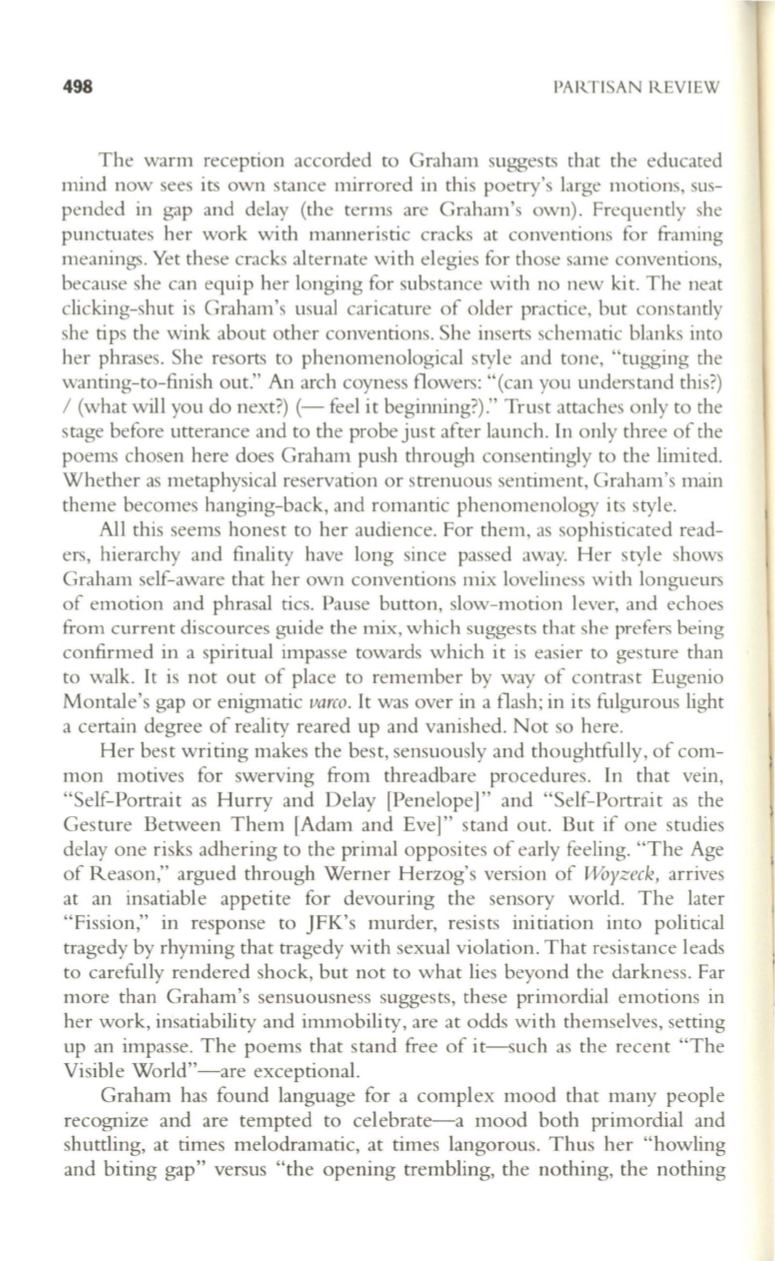
498
PARTISAN REVIEW
The warm reception accorded to Graham suggests that the educated
mind now sees its own stance nurrored in this poetry's large motions, sus–
pended in gap and delay (the terms are Graham's own). Frequently she
punctuates her work with manneristic cracks at conventions for franUng
mealungs. Yet these cracks alternate with elegies for those same conventions,
because she can equip her longing for substance with no new kit. The neat
clicking-shut is Graham's usual caricature of older practice, but constantly
she tips the wink about other conventions. She inserts schematic blanks into
her phrases. She resorts to phenomenological style and tone, "tugging the
wanting-to-finish out."
An
arch coyness flowers: "(can you understand this?)
/ (what will you do next?) (- feel it beginning?)." Trust attaches only to the
stage before utterance and
to
the probe just after launch. In only three of the
poems chosen here does Graham push through consentingly to the linuted.
Whether as metaphysical reservation or strenuous sentiment, Graham's main
theme becomes hanging-back, and romantic phenomenology its style.
All this seems honest to her audience. For them, as sophisticated read–
ers, hierarchy and finality have long since passed away. Her style shows
Graham self-aware that her own conventions nUx loveliness wi th longueurs
of emotion and phrasal tics. Pause button, slow-motion lever, and echoes
from current discources guide the nUx, which suggests that she prefers being
confirmed in a spiritual impasse towards which it is easier to gesture than
to walk. It is not out of place to remember by way of contrast Eugenio
Montale's gap or enigmatic
varco.
It was over in a flash; in its fulgurous light
a certain degree of reality reared up and vanished. Not so here.
Her best writing makes the best, sensuously and thoughtfully, of com–
mon motives for swerving from threadbare procedures. In that vein,
"Self-Portrait as Hurry and Delay [Penelope]" and "Self-Portrait as the
Gesture Between Them [Adam and Ever' stand out. But if one studies
delay one risks adhering to the primal opposites of early feeling. "The Age
of Reason," argued through Werner Herzog's version of
Woyzeck,
arrives
at an insatiable appetite for devouring the sensory world. The later
"Fission," in response to JFK's murder, resists initiation into political
tragedy by rhynung that tragedy with sexual violation. That resistance leads
to
carefully rendered shock, but not to what lies beyond the darkness. Far
more than Graham's sensuousness suggests, these primordial emotions in
her work, insatiability and immobility, are at odds with themselves, setting
up an impasse. The poems that stand free of it-such as the recent "The
Visible World"-are exceptional.
Graham has found language for a complex mood that many people
recognize and are tempted to celebrate-a mood both primordial and
shuttling, at times melodramatic, at times langorous. Thus her "howling
and biting gap" versus "the opening trembling, the nothing, the nothing


